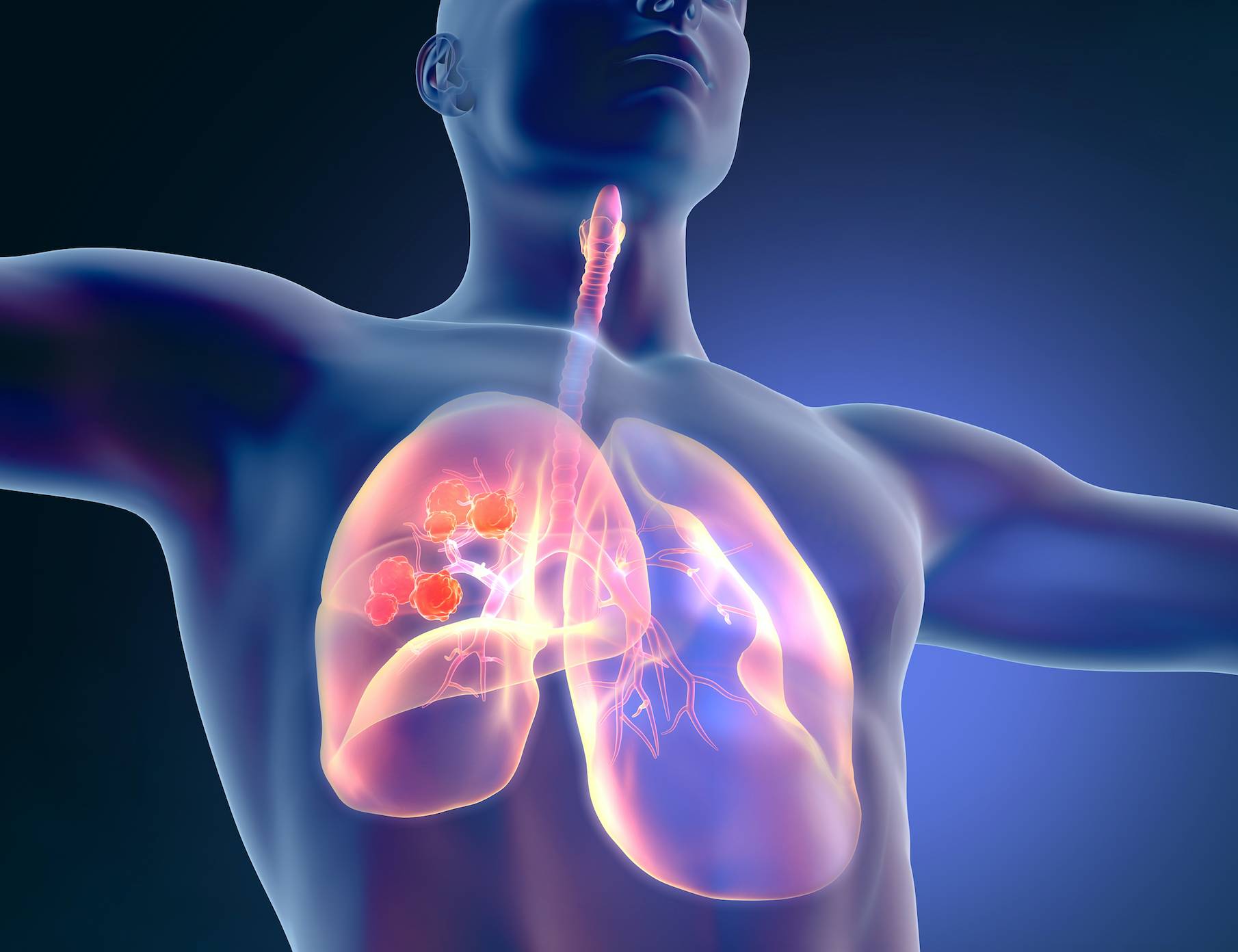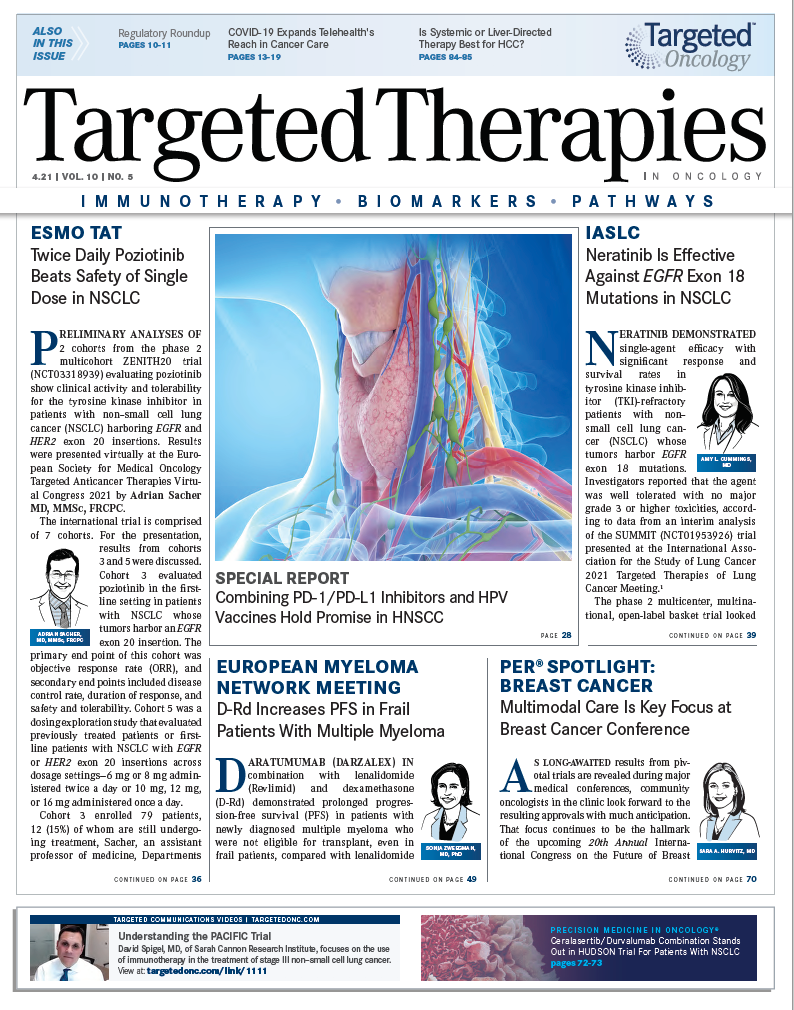Ceralasertib/Durvalumab Combination Stands Out in HUDSON Trial for Patients With NSCLC
For patients non–small cell lung cancer who previously progressed on chemotherapy and immune checkpoint inhibitors, ceralasertib plus durvalumab proved effective compared with patients with the same profile who received durvalumab alone, according to findings from the ongoing HUDSON study.

For patients non–small cell lung cancer (NSCLC) who previously progressed on chemotherapy and immune checkpoint inhibitors, ceralasertib plus durvalumab (Imfinzi) proved effective compared with patients with the same profile who received durvalumab alone, according to findings from the ongoing HUDSON study.1
The study’s primary end point was objective response rate (ORR), but preliminary data from the HUDSON (NCT03334617) trial, presented at the 2020 International Association for the Study of Lung Cancer World Conference on Lung Cancer (WCLC), also showed superior efficacy in the progression-free survival (PFS) and overall survival (OS) rates of patients on ceralasertib. Results show that the ATR kinase inhibitor is beneficial for high-risk patients with NSCLC who have limited treatment options after progressing on previous treatments.
“The prognostic profiles of patients enrolled based on predefined biomarker selection criteria can differ [from] those without predefined biomarker criteria. Patients with acquired resistance appear to have a higher life expectancy compared with those who relapse earlier,” explained Benjamin Besse, MD, lead author and member of the HUDSON study group, in an interview with Targeted Therapies in Oncology.
HUDSON Umbrella Trial Design
HUDSON is an open-label, biomarker-directed, multiarm, multicenter, phase 2 umbrella study evaluating 261 patients with NSCLC, as of this writing. Patients on the trial had to have previously received platinum doublet chemotherapy and experienced immune checkpoint inhibitor failure. All patients received durvalumab. Other therapies combined with durvalumab included ceralasertib, olaparib (Lynparza), and oleclumab (MEDI9447). Investigators used preexisting local next-generation sequencing data to enable rapid patient allocation to biomarker-matched groups.2
Overall, the HUDSON trial is evaluating the drivers of immune checkpoint blockade resistance and methods to overcome this resistance, to increase patient benefit from immune therapy. Investigators focused not only on patient biomarkers but also the resistance that patients had shown to previous treatment. According to Besse, head of the department of medical oncology at the Institut Gustave Roussy in Villejuif, France, the study design was focused on 2 patient populations with NSCLC, those with predefined biomarkers and those without.
In the preliminary data, those 2 populations were stratified into group A (n = 85), those with a matched biomarker profile, or group B, those with nonmatched profiles.
Group B was further divided into patients with acquired resistance (ACQ), defined as disease progression after more than 24 weeks of prior immunotherapy (FIGURE1), and primary resistance (PRI), defined as disease progression at 24 weeks from the onset of prior immunotherapy. Ninety-four evaluated patients were in the ACQ cohort, and 74 patients were in the PRI cohort, respectively.
Patient age ranged from 33 to 65 years. In the biomarker-matched ceralasertib arm, 94.4% of patients had a previous history of smoking. Also, in the biomarker-matched ceralasertib arm, 44.4% of patients had 3 or more lesions, whereas 39% and 41.7% of patients exhibited 3 or more lesions in the PRI and ACQ arms, respectively.
Results for Patients With NSCLC
Biomarkers that patients were matched with included patients with homologous recombination repair gene mutation (HRRm), STK11, ATM mutations in their tumor, CD73 molecule, HER2e (HER2 enriched), and HER2m (HER2 mutant). Patients with HRRm (n = 21) and STK11 (n = 21) mutations in their tumor were given olaparib (Lynparza) in combination with durvalumab, and patients with CD73 (n = 23) in their tumor were given oleclumab. HER2e and HER2m groups received fam-trastuzumab deruxtecan (Enhertu). The only biomarker patient group who received ceralasertib was those with ATM mutation in their tumor (n = 18). Enrollment for the HER2 groups is ongoing, and no results were available. However, median ORR was highest in the group with ATM, at 13.3%, with a median PFS of 7.43 months (80% CI, 3.45-9.46); 100% of patients were followed through after 6 months.1
ORR was not reached in the CD73 group but was reached in the HRRm group, at 4.8%, with the STK11 group reflecting the same ORR; however, the median PFS was greater in the HRRm group, at 2.79 months (80% CI, 1.48-5.26) compared with 1.41 months in the STK11 group (80% CI, 1.38-1.81). In group B, both patients with PRI and ACQ demonstrated higher ORR rates at 11.1% and 8.7%, respectively. The median PFS was also highest in these groups, at 4.24 months (80% CI, 1.94-6.77) in the PRI group and 4.96 months (80% CI, 3.55-5.98) in the ACQ group. The only other set of patients in group B to achieve an ORR was the olaparib arm of the PRI group, at 4.3% with a median PFS of 3.38 months (80% CI, 2.10-4.93).
“When the results of those different subcohorts are placed next to each other, as was done at the WCLC presentation, one can see how similar or different the numerical results are, as if one was comparing a series of single-arm trials,” explained Besse. “The responses from the ceralasertib cohorts indicate a more favorable efficacy than was seen in the other treatment combinations with similar maturity of data. It is, however, hard to conclude anything beyond this.”
The treatment schedule for ceralasertib consisted of a 7-day cycle followed by two 28-day cycles with dosing occurring on each day of the first cycle and days 22 to 28 of the 28-day cycles. Durvalumab was given on day 1 of the 28-day cycles. An exploratory analysis, also presented at WCLC by Besse, found that the combination treatment has a role in immune activation via ceralasertib.3 However, this was translational data from 8 patients in the ATM biomarker subcohort and 17 patients from the biomarker-negative group, and clinical data have yet to be presented.
The analysis found 4 different gene signatures for macrophages1-3 that decreased with ceralasertib. There was also a 2-fold reduction in peripheral IL-8 gene expression in paired blood samples among 19 patients considered to have controlled disease, defined by partial response or stable disease by RECIST v1.1 criteria, compared with the 6 patients showing progressive disease. During the ceralasertib-only period of treatment, the investigators found modified biomarkers displaying peripheral immunity with significant increases in antigen presentation, gene signature, and decreases in T-cell and natural killer cell signatures. Moreover, these changes in gene expressions were associated with the treatment, leading investigators to confirm whether these characteristics are to be considered prognostic or predictive of response.
HUDSON’s Impact on the Community Setting
Looking at the challenges ahead, Besse pointed out that community oncologists will need to make their own risk-benefit analysis for patients. The trial is ongoing, and safety is continually being monitored. However, he believes that the benefits outweigh the current adverse effects, making it a favorable choice for oncologists.
In particular, he highlighted the ability of community oncology practices to bring this clinical trial to patients who may not otherwise get it without access to hospitals in the academic setting, especially as phase 3 preparations ramp up.
References:
1. Besse B. HUDSON: An open-label, multi-drug, biomarker-directed, phase 2 platform study in patients with NSCLC who progressed on anti-PD(L)1 therapy. Presented at: International Association for the Study of Lung Cancer 2020 World Conference on Lung Cancer; January 28-31, 2021; Virtual. Abstract OA07.08. https://bit.ly/3lJ6bYC
2. Lao-Sirieix S, Heymach J, Forde P, et al. P2.01-07 Open-label, biomarker-directed platform study in NSCLC patients who progressed on an anti-PD-(L)1-containing therapy (HUDSON). J Thorac Oncol. 2019;14-10. doi: https://doi.org/10.1016/j.jtho.2019.08.1351
3. Besse B. Immuno-Modulatory Effects of Ceralasertib in Combination withdurvalumab in NSCLC with progression on anti-pd(l)1 treatment (HUDSON). Presented at: International Association for the Study of Lung Cancer 2020 World Conference on Lung Cancer; January 28-31, 2021; Virtual. Abstract p16.07. https://bit.ly/3lJ6bYC
